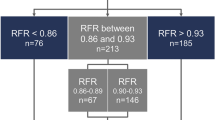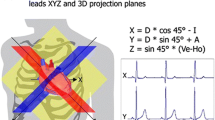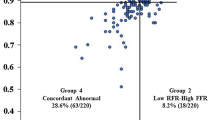Abstract
To test the usefulness of non-invasive coronary flow reserve (CFR) by transthoracic Doppler echocardiography by comparison to invasive fractional flow reserve (FFR) and instantaneous wave-free ratio (IFR), a new vasodilator-free index of coronary stenosis severity, in patients with left anterior descending artery (LAD) stenosis of intermediate severity (IS) and stable coronary artery disease. 94 consecutive patients (mean age 68 ± 10 years) with angiographic LAD stenosis of IS (50–70 % diameter stenosis), were prospectively studied. IFR was calculated as a trans-lesion pressure ratio during the wave-free period in diastole; FFR as distal pressure divided by mean aortic pressure during maximal hyperemia (using 180 μg intracoronary adenosine); and CFR as hyperemic peak LAD flow velocity divided by baseline flow velocity using intravenous adenosine (140 μg/kg/min over 2 min). The mean values of IFR, FFR, and CFR were 0.88 ± 0.07, 0.81 ± 0.09, and 2.4 ± 0.6 respectively. A significant correlation was found between CFR and FFR (r = 0. 68), FFR and IFR (r = 0.6), and between CFR and IFR (r = 0.5) (all, p < 0.01). Using a ROC curve analysis, the best cut-off to detect a significant lesion based on FFR assessment (FFR ≤ 0.8, n = 31) was IFR ≤ 0.88 with a sensitivity (Se) of 74 %, specificity (Sp) of 73 %, AUC 0.81 ± 0.04, accuracy 72 %; and CFR ≤ 2 with a Se = 77 %, Sp = 89 %, AUC 0.88 ± 0.04, accuracy 85 % (all, p < 0.001). In stable patients with LAD stenosis of IS, non-invasive CFR is a useful tool to detect a significant lesion based on FFR. Furthermore, there was a better correlation between CFR and FFR than between CFR and IFR, and a trend to a better diagnostic performance for CFR versus IFR.




Similar content being viewed by others
References
Van de Hoef TP, Siebes M, Spaan JA, Piek JJ (2015) Fundamentals in clinical coronary physiology: why coronary flow is more important than coronary pressure. Eur Heart J 36:3312–3319
Montalescot G, Sechtem U, Achenbach S, Andreotti F, Arden C, Budaj A et al (2013) 2013 ESC guidelines on the management of stable coronary artery disease The Task Force on the management of stable coronary artery disease of the European Society of Cardiology. Eur Heart J 34:2949–3003
Tonino PAL, Fearon WF, De Bruyne B, Oldroy KG, Leesar MA, Ver Lee PN et al (2010) Angiographic versus functional severity of coronary artery stenoses in the FAME study. Fractional flow reserve versus angiography in multivessel evaluation. J Am Coll Cardiol 55:2816–2821
Johnson NP, Tóth GG, Lai D, Zhu H, Açar G, Agostoni P et al (2014) Prognostic value of fractional flow reserve: linking physiologic severity to clinical outcomes. J Am Coll Cardiol 64:1641–1654
Sen S, Escaned J, Malik IS, Mikhail GW, Foale RA, Mila R et al (2012) Development and validation of a new adenosine-independent index of stenosis severity from coronary wave-intensity analysis: results of the ADVISE (ADenosine Vasodilator Independent Stenosis Evaluation) study. J Am Coll Cardiol 59:1392–1402
Escaned J, Echavarria-Pinto M, Garcia-Garcia HM, van de Hoef TP, de Vries T, Kaul P et al (2015) Prospective assessment of the diagnostic accuracy of instantaneous wave-free ratio to assess coronary stenosis relevance. Reuslts of the ADVISE II International Multicenter Study Adenosine Vasodilator Independent Stenosis Evaluation. J Am Coll Cardiol Intv 8:824–833
Petraco R, Escaned J, Sen S, Nijjer S, Assress KN, Echevarria-Pinto M et al (2013) Classification performance of instantaneous wave-free ratio (IFR) and fractional flow reserve in a clinical population of intermediate coronary stenoses: results of the ADVISE registry. EuroIntervention 9:91–101
Petraco R, van de Hoef TP, Nijjer S, Sen S, van Lavieren MA, Foale RA et al (2014) Baseline instantaneous wave-free ratio as a pressure-only estimation of underlying coronary flow reserve: results of the JUSTIFY-CFR Study (Joined Coronary Pressure and Flow Analysis to Determine Diagnostic Characteristics of Basal and Hyperemic Indices of Functional Lesion Severity-Coronary Flow Reserve). Circ Cardiovasc Interv 7:492–502
Hozumi T, Yoshida K, Ogata Y, Akasaka T, Asami Y, Takagi T et al (1998) Noninvasive assessment of significant left anterior descending coronary artery stenosis by coronary flow velocity reserve with transthoracic color Doppler echocardiography. Circulation 97:1557–1562
Caiati C, Montaldo C, Zedda N, Montisci R, Ruscazio M, Lai G et al (1999) Validation of a new noninvasive method (contrast-enhanced transthoracic second harmonic echo Doppler) for the evaluation of coronary flow reserve: comparison with intracoronary Doppler flow wire. J Am Coll Cardiol 34:1193–1200
Lethen H, Tries HP, Brechtken J, Kersting S, Lambertz H (2003) Comparison of transthoracic Doppler echocardiography to intracoronary Doppler guidewire measurements for assessment of coronary flow reserve in the left anterior descending artery for detection of restenosis after coronary angioplasty. Am J Cardiol 91:412–417
Meimoun P, Sayah S, Luycx-Bore A, Boulanger J, Elmkies F, Benali T et al (2011) Comparison between non-invasive coronary flow reserve and fractional flow reserve to assess the functional significance of left anterior descending artery stenosis of intermediate severity. J Am Soc Echocardiogr 24:374–381
Diamon M, Watanabe H, Yamagashi H, Muro T, Akika K, Hirata K et al (2001) Physiologic assessment of coronary artery stenosis by coronary flow reserve measurements with transthoracic Doppler echocardiography: comparison with exercise thallium-201 single photon emission computed tomography. J Am Coll Cardiol 37:1310–1315
Rigo F, Sicari R, Gherardi S, Djordjevic-Dikic A, Cortigiani L, Picano E (2008) The additive prognostic value of wall motion abnormalities and coronary flow reserve during dipyridamole stress echo. Eur Heart J 29:79–88
Meimoun P, Benali T, Elmkies F, Sayah S, Luycx-Bore A, Doutrelan L et al (2009) Prognostic value of transthoracic coronary flow reserve in medically treated patients with proximal left anterior descending artery stenosis of intermediate severity. Eur J Echocardiogr 10:127–132
Wada T, Hirata K, Shiono Y, Orii M, Shimamura K, Ishibaschi K et al (2014) Coronary flow velocity reserve in three major coronary arteries by transthoracic echocardiography for the functional assessment of coronary artery disease: a comparison with fractional flow reserve. Eur Heart J Cardiovasc Im 15:399–408
Berry C, van’t Veer M, Witt N, Kala P, Bocek O, Pyxaras SA et al (2013) VERIFY. Verfication of instantaneous wave-free ratio and fractional flow reserve for the assessment of coronary artery stenosis severity in everyday practice. J Am Coll Cardiol 61:1421–1427
Johnson NP, Kirkeeide RL, Gould K (2012) Is discordance of coronary flow reserve and fractional flow reserve due to methodology or clinically relevant coronary pathophysiology? J Am Coll Cardiol Cardiovasc Imaging 5:193–202
Gould L (1978) Pressure-flow characteristics of coronary stenoses in unsedated dogs at rest and during coronary vasodilation. Circ Res 43:242–253
Nijjer SS, Sen S, Petraco R, Davies JER (2015) Advances in coronary physiology. Circ J 79:1172–1184
Meuwissen M, Siebes M, Chamuleau SA, van Eck-Smit BL, Koch KT, de Winter RJ et al (2002) Hyperemic stenosis resistance index for evaluation of functional coronary lesion severity. Circulation 106:441–446
Matsumura Y, Hozumi T, Watanabe H, Fujimoto K, Sugioka K, Takemoto Y et al (2003) Cut-off value of coronary flow velocity reserve by transthoracic Doppler echocardiography for diagnosis of significant left anterior descending artery stenosis in patients with coronary risk factors. Am J Cardiol 92:1389–1393
Tarkin JM, Nijjer S, Sen S, Petraco R, Echavarria-Pinto M, Assress KN et al (2013) Hemodynamic response to intravenous adenosine and its effect on fractional flow reserve assessment: Results of the adenosine for the functional evaluation of coronary stenosis severity (AFFECTS) study. Circ Cardiovasc Interv 6:654–661
Nogushi Y, Nagata-Kobayashi S, Stahl JE, Wong JB (2005) A meta-analytic comparison of echocardiographic stressors. Int J Cardiovasc Im 21:189–207
Ziadi MC, Dekemp RA, Williams KA, Guo A, Chow BJ, Renaud JM et al (2011) Impaired myocardial flow reserve on rubidium-82 positron emission tomography imaging predicts adverse outcomes in patients assessed for myocardial ischemia. J Am Coll Cardiol 58:740–748
Naya M, Tamaki N, Tsuitsui H (2015) Coronary flow reserve estimated by positron emission tomography to diagnose significant coronary artery disease and predict cardiac events. Circ J 79:15–23
Norgaard BL, Leipsic J, Gaur S, Seneviratne S, Ko BS, Ito H et al (2014) Diagnostic performance of noninvasive fractional flow reserve derived from coronary computed tomography angiography in suspected coronary artery disease the NXT trial (analysis of coronary blood flow using CT angiography: next steps). J Am Coll Cardiol 63:1145–1155
Kakuta K, Dohi K, Yamada T, Yamanaka T, Kawamura M, Nakamori S et al (2014) Detection of coronary artery disease using coronary flow velocity reserve by transthoracic Doppler echocardiography versus multidetector computed tomography coronary angiography: influence of calcium score. J Am Soc Echocardiogr 27:775–785
Van de Hoef TP, van Lavieren MA, Damman P, Delewi R, Piek MA, Chamuleau SA et al (2014) Physiological basis and long-term clinical outcome of discordance between fractional flow reserve and coronary flow velocity reserve in coronary stenoses of intermediate severity. Circ Cardiovasc Interv 7:301–311
Author information
Authors and Affiliations
Corresponding author
Ethics declarations
Conflict of interest
The authors declare that they have no conflict of interest.
Informed consent
Informed consent was obtained from all individual participants included in the study.
Research involving human rights
All procedures performed in studies involving human participants were in accordance with the ethical standards of the institutional and/or national research committee and with the 1964 Helsinki declaration and its later amendments or comparable ethical standards.
Rights and permissions
About this article
Cite this article
Meimoun, P., Clerc, J., Ardourel, D. et al. Assessment of left anterior descending artery stenosis of intermediate severity by fractional flow reserve, instantaneous wave-free ratio, and non-invasive coronary flow reserve. Int J Cardiovasc Imaging 33, 999–1007 (2017). https://doi.org/10.1007/s10554-016-1000-3
Received:
Accepted:
Published:
Issue Date:
DOI: https://doi.org/10.1007/s10554-016-1000-3




